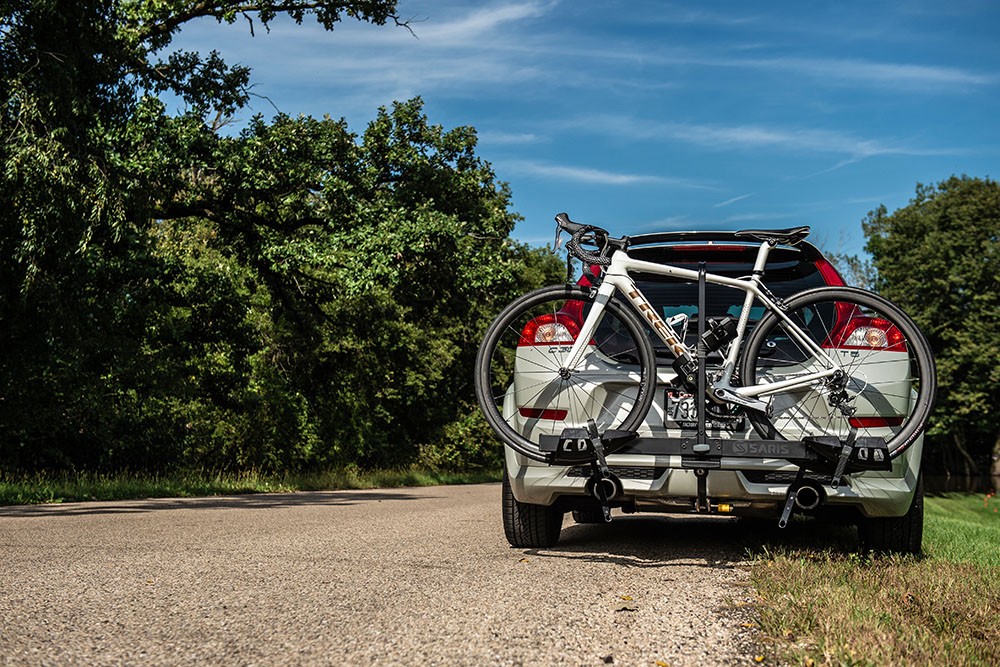Your Next Bike Trek Begins Here

Dreaming of a springtime bike adventure is wonderful. Planning a springtime bike adventure can be a bit of a conundrum.
While all cars can be outfitted with a bike rack, most vehicles have specific requirements and connectors.
“Every year I get calls from drivers who lost their bikes on the freeway,” said Kellen Pagel, the rack category manager at Saris, a Wisconsin-based bike hitch manufacturer. “First thing I ask: Did you follow the installation instructions?”
Pagel has worked with Saris for 15 years and has seen or heard just about every problem possible with bike racks. He’s tested, toted, tweaked, prodded, poked and saddled every rack made by Saris.
One of his personal goals is to educate customers--no matter what product they use--on safe ways to shuttle bikes.
“Start by looking at the different types of solutions available,” Pagel said. “It’s also important to look at the styles and weight of the bikes you want to carry.”
Bike racks generally fall into three categories: trunk-mounted, hitch mounted and roof-mounted.
“Remember, you are strapping something onto your vehicle, adding weight to it and then driving around,” Pagel said. “You want confidence it will work properly.”
A trunk mounted rack generally is the least expensive choice. They have connectors that fit into the top and bottom of the trunk panel.
“Racks may not work on some vehicles or they have special fit instructions,” Pagel said. “Do a little research before buying to make sure it is going to work for you.”
A note of caution from Pagel: Trunk-mounted racks may cause bikes to come into contact with each other or scratch the paint on the vehicle itself--if not properly installed. They also have lower carry weight ratings than hitch-mounted or roof-mounted racks.
In contrast, hitch-mounted racks slide into the receiver tube on the hitch. They offer good support and prevent bikes from coming into contact with the vehicle.
“What kind of bikes are you carrying?” Pagel asked. “How many bikes? How much do they weigh?”
The popularity of electronic bikes has changed hitch design dramatically.
“A traditional bike may weigh 30-35 pounds,” Pagel said. “An ebike may weigh twice that.”
All hitches have specific weight limits. Estimate out how much weight you intend to carry before making a rack purchase. Refer to the instruction manual to determine the receiver type needed for maximum carrying weight.
Bikes made out of lightweight materials such as carbon fiber require extra care. Resting it on a hitch arm could cause the bike frame to bend or break.
“Put that bike on a tray rack,” Pagel said. “They’re easy to load and the bikes won’t come into contact with each other.
Tray bike racks also fit snugly into the hitch receiver tube. Yet, the weight of the bike rests on the stand rather than a rack arm. Some tray racks offer locks to prevent theft.
“Make sure to look at the design and features you want in a rack.”
A roof rack may make sense for drivers who want quick access to the cargo spaces, Pagel explained. The downside: Drivers sometimes do not account for the height of bikes when entering their home garage or other tight spaces. Also, roof racks tend to increase wind resistance and lower fuel economy.
Pagel had the following recommendations when purchasing a bike rack:
- Choose a bike rack fitted to your specific vehicle. Check the “fit guide” either online or in the retail store.
- Trunk racks are an inexpensive way to transport bikes and fit almost any type of car without requiring drivers to purchase a hitch.
- Clean rack pads to prevent scratching the paint when installing a trunk rack. Never set the rack feet directly on the ground to keep them as clean as possible and free from small pieces of stone.
- Find out if the trunk rack can fit the weight of your bikes and whether it prevents bikes from coming into contact with each other or bouncing when you drive.
- Determine how many bikes you intend to carry. Sometimes the weight limit is a total of all bikes being transported; other times weight limits are shown per bike.
- Hitch racks are designed to carry multiple bikes and do not allow bikes to come in contact with each other. They usually have optional accessories to prevent theft.
- Bikes that do not have a horizontal tube may require a “tube leveler” before they can be attached to the rack.
- eBikes require racks that can support their weight. Make sure to review product guidelines.
“A strap-type rack typically does not work for carrying ebikes,” Pagel said.
- Some drivers prefer a roof rack to get quick access to the trunk cargo. They may cause more wind resistance and lower fuel economy, however. Also, drivers must exercise extra caution when driving to prevent vehicle damage when entering garages.
- Use tray racks for composite bikes that require extra care when transporting. These types of racks allow the bike to rest on a channel rather than a rack arm.
“It’s important to follow rack installation directions,” Pagel said. “Otherwise, you could buy the most expensive rack available and still have a bad experience.”